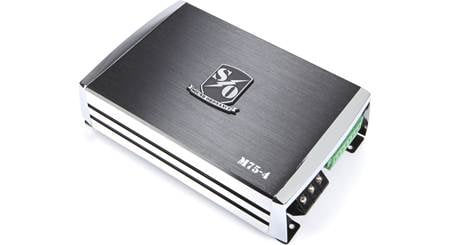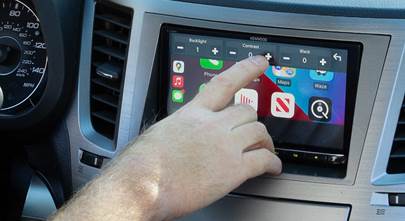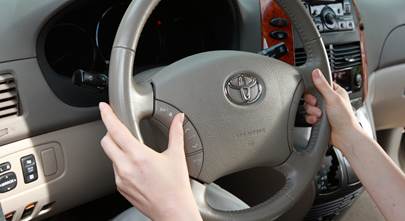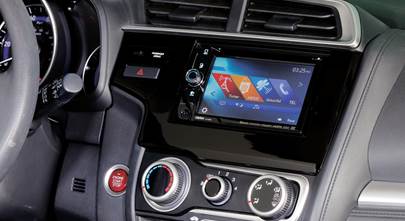12 tips for the best sound quality in your car
Get the best car audio setup with our expert advice
The best car sound systems rely on decent gear and a little know-how. Even the simplest improvements to your car audio system can yield noticeable results. In this article, I've gathered some advice to help improve the sound in your car.
A
car can be a great place to enjoy music, but many commuters still put up with marginal sound quality that they'd never tolerate at home. Others assemble sophisticated sound systems for their cars, then make common installation mistakes that keep the system from reaching its full potential. Many of these tips can be used for both existing systems and more sophisticated setups you may be contemplating.

New speakers can make a big difference in the sound.
Tip #1: Replace your car's speakers
In most cases, the speakers are just about the last thing a manufacturer thinks about when designing and building your car. Factory audio systems have gotten better over the last few years, but many so-called "premium" systems still use relatively weak amps and speakers that don't deliver top-notch sound. And if your vehicle’s a little older, the existing speakers have probably had their fair share of wear and tear.
You can make a big difference in your car audio system's sound quality by installing a nice set of aftermarket speakers. You'll hear tighter bass and more overall clarity, and you'll most likely notice details you've never heard before in songs you've known for years.
Replacement speakers give you maximum bang for your buck, so they're a terrific first step on the road to better sound. And if you want to know the best car speakers for bass, see tip #5.

This Pioneer stereo lets your manually adjust the equalizer bands or use one of the presets for your music.
Tip #2: Don't max out your tone controls
Like a guitar, all the best car sound systems perform better when they're properly tuned.
Boosting your factory radio's tone controls all the way up might make your system sound better in your driveway, but it just creates distortion when you turn the volume up on the highway. A heavy low-frequency boost, in particular, will put a big strain on your factory system. If you want to fatten up your sound, try using a smaller boost in the bass, lower the highs and mids a touch, and then turn up your overall volume a little more.
But maybe you've replaced (or you’re thinking about replacing) your factory radio with an aftermarket stereo that features a multi-band equalizer. The same rule still holds true — avoid excessive tone boosts or cuts. A bad EQ setting can make a good system sound terrible, while an intelligent tone curve can make a good system sound great.
If you can, program a few different EQ presets into your receiver, so you can see what works best in your car without having to adjust settings while you're driving. Or cycle through your receiver's preset curves to see if one of them sounds particularly good at highway speed, then customize that setting in your driveway. If you have a copilot, let them switch between the settings. And if you’re looking to dig deeper into some serious sound-shaping, check out Tip #11.
What to look for in a car stereo

The Kenwood Excelon KMM-X704 uses a high-quality DAC to bring out the details in your music.
Tip #3: Use a better digital-to-analog converter (like the one in an aftermarket car stereo)
A digital-to-analog converter, or DAC, has the job of converting digital information — 0's and 1's — into analog music signals. In most cases, your music player is probably your smartphone. Its built-in DAC usually does a good enough job for casual listening with earbuds, but it doesn't deliver the same level of performance you can get from the more advanced DACs found in many of today's better aftermarket car stereos.
Connecting your smartphone to an aftermarket stereo via a USB cable lets you use the stereo's DAC. This decodes your music with maximum detail and strongest sound.
Learn more about getting the best sound from your portable music player

Tip #4: Use the best source material by using higher quality music files
Yes, you can store more music files in your portable music player or phone if you use greater compression, and they'll sound okay when you're listening through earbuds. But compressing your music means you lose some high- and low-frequency information and some of the details that make your music interesting. Certain aspects of a song may not sound quite right (such as "swishy" cymbals).
On a good car audio system, you can really tell that something's missing. Using better quality source material is an improvement you’ll notice right away.
When you’re adding to your digital library, don't settle for the default setting when creating your files or buying digital music. Use as little compression as possible. The higher the bit rate, the better your music will sound through your car's audio system. Higher bit rates will take up more storage, but the advantage in sound quality can be well worth it.
And when you stream music, explore the settings in your favorite music app to step up your audio quality. You can also use a music service that streams in a higher resolution, like TIDAL or Qobuz. Just be aware that streaming at a higher bit rate will consume more data.
Learn more about high-res formats

Adding an amplifier to your system enables your speakers to show off more depth, clarity, and volume.
Tip #5: Add a car amplifier
When friends ask me, "What are the best car speakers for bass?" My answer is always: "An amplifier." That's because no matter how good your speakers are, you'll get their best performance by adding more power (within their performance specs, of course).
You may be saying, "My factory stereo puts out 200 watts, and that's plenty of power." But there's a huge difference between 50 watts peak power per channel produced by your car stereo and 50 watts RMS continuous power (a more realistic rating) from an outboard amplifier.
A separate amplifier will provide more clean power than any car stereo, and that'll make a night-and-day difference in sound quality. Your system will sound better, whether you listen to a Mahler symphony at a conversational level or Metallica turned up to 11. An amplifier is essential to getting great sound in your car.
Even if you’re keeping your factory radio, you can still add an amplifier. Check the amp you’re considering to see if it includes "speaker-level inputs," which allow you to tap into factory speaker wiring to acquire the audio input that an amp needs.
Learn more about car amplifiers

Setting the gains properly on this Sound Ordnance amp will keep your system distortion-free.
Tip #6: Set your amp gains properly
Our Tech Support people field calls every day from customers who can't understand why their new car audio system sounds so bad. The #1 problem? Most people think the gain control on their new amplifier controls the volume level. Naturally, they turn it all the way up, which causes bad things to happen. The gain control actually adjusts the amount of input signal coming into the amplifier. When you crank it up too high, you'll hear some seriously nasty distortion.
The general idea is to turn your receiver's volume control roughly 3/4 of the way up to maximum volume, then turn up your amp gain until you hear distortion. Back it off a little, and you're all set. Every amp manufacturer will have specific suggestions, so you'll want to check out your manual for the best way to set the gain on your new amplifier.
Learn more about setting up your new amp
Tip #7: Your crossover can really improve the sound of your system
Many in-dash receivers now include frequency filters that'll work with your preamp and speaker outputs. If you have a sub, use the stereo's high-pass filter to remove the low bass from your car's full-range speakers. You'll get more clean volume out of them, particularly if you're driving them with the receiver's built-in power.
Or maybe your sub sounds really strong, but the bass sounds like it's coming from behind you. Experiment with raising or lowering the crossover point on your low-pass filter, and you'll be able to bring the bass up forward with the rest of the music.

Front and rear frequency filters help you tune the sound of your music.
Many amplifiers feature subsonic filters that remove super-low bass below the range of human hearing. Go ahead and turn it on — your amp and sub will run cleaner without that subsonic sludge. Also, the compression you use to create your music files can cause a low-frequency sputtering sound in your subs. Your subsonic filter will remove or minimize this noise.
Important: When setting crossovers, only adjust the crossovers on one part of your system. For example, if you adjust the crossovers for all the speakers in your system using your car stereo, you should run your amps at full range (crossovers off). Conversely, the car stereo’s crossovers should be off, or set to full range, if you’re making the adjustments on your amplifier(s) instead. If you use more than one component to adjust crossover settings, your system could get conflicting frequency information, which will negatively affect the sound.
Common questions about crossovers

Installing a subwoofer in your system, even a small powered sub like this JBL, will add bass to your system and take stress away from your speakers.
Tip #8: Add a subwoofer and hear what you've been missing
I've installed a lot of car audio systems, and I still love to see that "Wow" moment when somebody hears a sub in their car for the first time. A good subwoofer will bring the bottom octave of your music back into proper balance, so you'll hear familiar tunes in a whole new light. A subwoofer will take a load off your full-range speakers too, since you'll be playing your tunes with the stereo's bass control set at "0" instead of "+5".
Some people develop a negative opinion of subwoofers when they sit next to a thumping, vibrating car at a traffic light. But subs aren't just about the boom — you can adjust any subwoofer to fit your musical tastes and your vehicle. And once you drive with a subwoofer, you can never go back to living without one. Or two.
Watch our video on adding a powered sub

Tip #9: Build a better subwoofer box. Or buy one.
If you're building a sealed subwoofer box, make sure it's sealed properly. Air leaks can really hurt your sub's performance. If you're using a ported box, make sure you've got the right woofer in there. You can destroy a sub that's designed for a sealed box by driving it hard in a ported enclosure. Also, it's important to build a box with the correct interior volume for the sub you've picked out. A mismatch can result in poor performance or a sub fatality.
You can also avoid all of these issues by buying a premade enclosure that'll work with your subwoofer.
How do you know which type of box is right for you? Read our article exploring the difference between sealed and ported subwoofer boxes.

A capacitor provides some stored power for those heavy bass thumps.
Tip #10: Use a capacitor if you're going to push your subs hard
The people who designed your car probably didn't have subwoofers in mind when they built your vehicle. Big bass sucks up a lot of power, and most car electrical systems aren't equipped to deal with it.
A capacitor acts as a power reserve between your amplifier and your car's battery. You connect the cap inline on the power cable from your battery, as close to the amp as possible. It stores up power from your alternator, then releases it instantly to satisfy your amp's demand for the power needed to reproduce a big bass hit.
Have you ever noticed a big drop-off in performance after running your subs loud and hard for a minute or two? Or watched your headlights dim in time to the music while you're driving at night? A capacitor cures these problems by taking the brunt of those demand peaks away from your electrical system, so your amp sees a more consistent supply of power.
Read more about capacitors and power issues
Tip #11: Add a signal processor or an equalizer
The interior of a car presents some serious problems when it comes to sound quality. Glass and plastic surfaces reflect sound like crazy, while carpet, seat covers, and other absorbent materials soak it up. Add poorly placed speakers to the mix, and you wind up with significant frequency response peaks in most car interiors. These peaks make your music boomy in the bass or shrill in the upper frequencies, causing "ear fatigue."

AudioControl's EQL equalizer features 13 bands of equalization, and its level matching controls get maximum voltage to your amps.
Most car receivers give you treble, midrange, and bass controls — useful for global fixes but not for zeroing in on problem areas. You'll need an equalizer to kill these peaks, whether it's built into your receiver or in a processor mounted in your dash or near your amplifiers.
An outboard equalizer gives you multiple points for adjusting frequency response, so you can iron out those peaks in your system. A parametric equalizer allows you to vary the centerpoint and width of each EQ band, so you can really zero in on a problem area. Sound processors help you eliminate frequency response peaks and increase bass response, and some even include a microphone for analyzing your car's acoustics.
Setting your equalizer for the best sound
Proper use of an EQ can take some tweaking and lots of listening, but that's the fun part. Start with everything set "flat" and tweak one or two things at a time. You'll start figuring out what's missing in the sound and what there's too much of. Before long, with the equalizer's help, you'll have it dialed in just right.
Shop car equalizers and signal processors

This Dynamat door kit will help eliminate distortion from the speakers in your vehicle's doors.
Tip #12: Use sound deadening material
By reducing vibration and road noise, Dynamat, Hushmat, and other sound-deadening products do two things to make your system sound better.
First off, a door panel isn't the best place for a speaker — the thin metal vibrates as your music plays, which affects the accuracy of the sound. When you attach these products to your door panel, they deaden those vibrations and create a more stable platform for your speaker, more like the wooden baffle on a home speaker.
Second, have you ever noticed how your system sounds really good at 25 mph, but gets a little harsh when you hit 60? Road noise tends to mask the lower frequencies first, so your system sounds overly bright when you turn it up at highway speeds. Sound-deadening material lowers interior noise levels in your car, so you don't have to turn your music up as loud when you're driving. You'll hear more musical detail, and your amps won't have to work as hard. And that's all good.
In addition to the bulk packages of sound deadening materials, we also carry a wide selection of vehicle-specific sound deadening kits. These kits contain pieces that are already sized and shaped to be a better fit for each vehicle. This will make it easier to install them and cut down on your installation time.
Shop vehicle-specific sound deadening
Watch our video on installing Dynamat

EFX Delta patch cables offer excellent signal transfer with minimal noise.
Bonus Tip: Use high-quality cables for your amplifiers
Electricity is like running water. You wouldn't run a garden hose from the street main to your house, because not enough water would get through to keep up with demand. That's why you don't want to use cheap, undersized power cable to get power to your amplifiers — the amp will be starved for power when you start pushing up the volume control. A good power cable allows current to flow freely so your amp gets the juice it needs during peak demand.
High-quality patch cables promote better signal flow from your receiver to your amps, so you hear a more focused, detailed sound. And good patch cables will also reject noise caused by your car's electrical system. Don't believe cables can make a difference? Listen to three of your favorite songs on your home audio system using cheap or "in-the-box" RCA cables. Note what you heard (or didn’t hear) from each. Then listen to those same songs after switching to upgraded RCA cables and see if you can hear the difference. You'll hear those same differences in a car audio system with upgraded cables, too.
Plus, upgraded cables can just plain look cool, especially when you’re showing off the installation work you did.
Watch our amplifier installation video
Looking for more advice or ideas?
Crutchfield is here to help! Give us a call or contact us via chat, and one of our advisors will work with you to find the right audio solution for your vehicle.



















Tony from Minneapolis
Posted on 8/19/2023
good article, I;'m a Recording Engineer, Audiophile and Electrician, great tips with a lot of insight some i knew, some i didn't know, and a some in between. thank you for the info.
Puneet from India
Posted on 7/23/2023
Best and useful tips sir.. I am music lover and like heavy sound in my car and even at hime.. The things shared above will help alot and out of that few settings I have already done.. Yes I am using Amplifier, underseat woofer, 4 JBL door speakers and 6 tweeters.
Wyman R Kirkland from 27265
Posted on 5/23/2023
Yes Dave, all these tips would help but I need to buy for a specific vehicle and you guys fell short on my 2016 Toyota 4Runner - factory "Entune". I upgraded 2 other simpler vehicles using your Sony head units and they worked great! The Toyota proved more complicated. Short falls: 1) dash speakers did not offer plug for wiring harness - I will not cut the factory harness. 2) The mounts for the Sony unit were weak compared to the factory Panasonic mounts. 3) Wiring kit did not integrate Sirius radio. It was just not a clean install. The factory Panasonic unit sounds bad and lacks Apple Car Play. I tried your Sony solution but wound up sending it back. A true plug and play solution should be possible. Your engineers can do better.
Rip Woodward from New Orleans
Posted on 12/17/2022
Wow Dave, great advice and you have women in the comments letting you know they are single and leaving a number for You. Please share your secrets with the rest of us guys.
Michael from Chester
Posted on 10/14/2022
George Brent... on response to your question about the high pitch whine.. I have a Z28 Camaro that had the same problem. I traced it back to the simple fact that the Amp power cable was in close proximity to the ignition wiring. I moved the Amp power cable to the drivers side fender and across and behind the radiator, away from all factory wiring , and it solved my problem.
George E Brent Jr from Hagerstown
Posted on 10/10/2022
Classic (1977 Corvette) car with a retro sound radio, i'm getting a high pitch whine while driving. What causes that, can it be fixed
Stefan Ljungberg from Stockholm
Posted on 9/5/2022
GREATE TIPS. I would like to ad one more. A stronger car battery.
Cindy from Encinitas, CA
Posted on 7/30/2022
Hi David, can you replace my speakers in my car when I am in C'Ville for my daughter's graduation from UVA in December 2022? I totally love the speaker quality that you installed in our Highlander in Crozet many years ago. The music sounded totally awesome after your upgrades. Still have same last name though I am single now. Hope to hear from you. :-)
Jeff from New Market
Posted on 5/4/2022
Of all the great info in the article and comments, no one has mentioned fast rings or foam around newly installed aftermarket speakers. I've been a Crutchfield customer since '95 and have installed systems in every vehicle since then. I prefer using an aftermarket EQ in the dash, sound deadening, aftermarket speakers, amps and subs, etc. But i'd say the one thing that makes the most difference when putting speakers in factory door locations is using the foam rings. They are expensive considering what they are, but they install quick and easy and make a huge difference in mid-bass performance. Definitely should be on the list somewhere.
Anthony LaGrasta from Mission Viejo, CA
Posted on 5/4/2022
Excellent, excellent advice. As always, Crutchfield rocks!